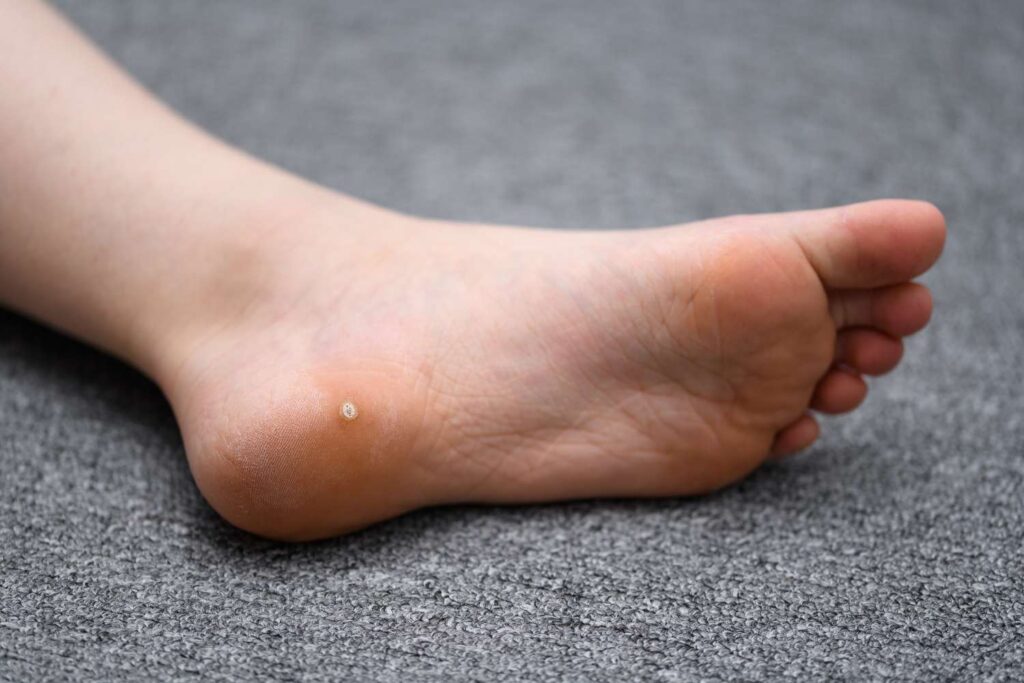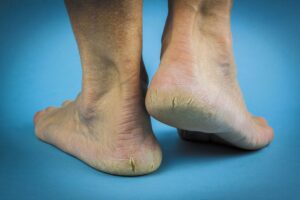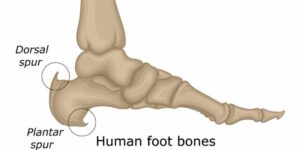Plantar warts, also known as verruca warts, are a common skin condition caused by the Human Papilloma Virus (HPV). They typically appear on the sole of the foot and can be painful and uncomfortable. While they are not usually a serious health concern, they can be contagious and may require treatment to alleviate symptoms.
Key Questions Considered in this Article:
- What are the causes of plantar warts and how is the Human Papilloma Virus (HPV) involved?;
- Who is at risk of developing plantar warts and why?;
- What are the common symptoms associated with plantar warts?;
- How are plantar warts diagnosed by healthcare professionals?;
- What are the various treatment options available for plantar warts, including both medical and at-home remedies?;
- What complications can arise if plantar warts are ignored or left untreated?;
- How can plantar warts potentially develop into a more serious health issue?;
- What are the key takeaways regarding the management and importance of seeking treatment for plantar warts?
Unveiling the Causes and Risk Factors
HPV, abbreviated for Human Papillomavirus, is a slow-progressing virus that is primarily transferred via direct or indirect contact. You can acquire it straight from an infected individual, or indirectly by sharing common surfaces or personal items like footwear with someone carrying the virus. However, it’s essential to note that susceptibility to the virus varies with each individual’s immune response.
HPV thrives in warm and damp conditions, making public venues like communal showers and pools its favorite breeding grounds. The virus usually invades your body through skin breaks or cuts.
In a remarkable display of viral activity, the virus targets the skin on the soles of your feet, prompting the top skin layer to proliferate rapidly and develop into a fleshy raised lesion, commonly referred to as a plantar wart.
While plantar warts can affect anyone, several factors can amplify one’s risk of contracting this type of foot wart. These include:
- Age: The likelihood of getting plantar warts is high in children and teenagers, attributable to their frequent use of public spaces such as school pools. Plus, their immunity against viruses is still developing, making them more vulnerable;
- Immunity: A weakened immune system increases susceptibility to plantar warts, as it’s less equipped to ward off the HPV strains that cause warts;
- Barefoot Walking: Traversing communal areas, particularly virus-prone zones such as locker rooms and communal showers, without any protective footwear can expose your feet to the wart-causing virus;
- Foot Injuries: Any cuts, abrasions, or skin infections on your feet act as a gateway for the virus to invade your body, heightening the risk of warts;
- Direct Contact: Having direct skin-to-skin contact with wart-affected individuals can lead to infection.
Recognizing the Symptoms of Plantar Warts
Plantar warts can exhibit a variety of characteristics due to their viral origin. Blood vessels start forming in the center of the wart, supplying it with essential nutrients. The capillaries may appear as tiny dark dots in the wart’s center. Pain can accompany a plantar wart, particularly when located in an area of the foot bearing the body’s weight. This body weight exerting pressure on the wart can lead to discomfort.
Here are a few telltale signs you may notice if you’ve got a plantar wart:
- A rough-textured, granular growth on the sole, especially on the toes, one of the foot’s balls, or heel areas;
- The growth has defined boundaries;
- The presence of dark black spots within the growth;
- A layer of hardened skin with a yellowish tint might cover the lesion;
- The lesion could cause pain when its borders are squeezed;
- Walking becomes painful if the wart emerges on a part of the foot bearing weight;
- Disruption of the foot’s normal skin markings by a lesion;
- The presentation of multiple similar-looking growths in a single location, also referred to as a mosaic wart.

Diagnosing Plantar Warts: The Squeeze Test and Beyond
If you’ve observed several symptoms associated with plantar warts, using the Squeeze Test might aid self-diagnosis. This test differentiates between warts and corns. To perform the test, apply pressure on either side of the growth – if it causes pain, the likelihood leans more towards a wart than a corn.
However, self-diagnosing may not always offer conclusive results, and it’s advisable to see a podiatrist. The treatment strategies for warts and corns differ significantly, and the right diagnosis can ensure proper management.
A trained podiatrist can typically identify a wart just by examining it. Yet, if the diagnosis isn’t straightforward, your podiatrist might take a sample of the growth for further analysis and confirmation.
Combatting Plantar Warts: Treatment and Management
Plantar warts aren’t always persistent; however, they frequently necessitate removal due to their proclivity to cause pain, given their placement on the sole of the foot. While some may disappear with a few treatments, others, particularly those that have been around for a while, could take several months to fully clear.
An experienced podiatrist can offer various treatment avenues to help tackle plantar warts effectively. These may include:
- Swift Therapy: This innovative approach utilizes medical microwave technology that’s been proven highly effective in eradicating warts. It allows for delivering a concentrated microwave signal that heats the wart tissue rapidly. Although brief, this rapid heating can induce discomfort which is mitigated by the procedure’s short duration. Swift therapy boats a high success rate ranging from 75-83%;
- Sharp Debridement: This involves careful removal of the tough outer layer of wart tissue, revealing the softer layer underneath;
- Usage of Mild Acids: Mild acids, under careful supervision, can be used to erode the wart tissue gradually;
- Cryotherapy: This approach involves using sub-zero temperatures to freeze the wart, ideally causing the infected tissue to die off;
- Minor Surgery: In severe cases, a minor surgical procedure under local anesthesia may be needed to completely remove the wart.
Expanding on a few of the above treatments:
Leveraging Swift Therapy
Swift Therapy employs medical microwave technology to deliver a focused microwave signal to the skin, essentially targeting only the wart. Although a brief rise in temperature can cause discomfort, the discomfort ends almost as soon as the treatment does. No dressings are required post-treatment, and normal activity can be resumed right after the session.
Understanding In-Clinic Chemical Treatments
Chemical treatments commonly used in clinics for warts include:
- Silver Nitrate: This gentle chemical is applied to the wart tissue to cause tissue trauma, inciting the body’s immune system to take action and fight off the infection;
- Salicylic Acid: Typically applied to the lesion as a paste after debridement, salicylic acid reacts with the skin, causing tissue damage in an attempt to trigger the immune response.
The frequency and duration of such treatments largely depend on the size of the wart and infection duration.
Exploring Cryotherapy
Cryotherapy involves applying a freezing agent, typically liquid nitrogen, directly to the wart. The freezing sensation can be uncomfortable and may lead to a blister that should resolve over the following days. This treatment is usually spaced 2-4 weeks apart until the wart resolves.
Resorting to Surgical Removal
When all else fails, surgery comes into play. A surgical procedure called curettage involves numbing the area around the wart with a local anesthetic and removing the wart tissue to expose healthy skin.

Empowering Yourself: Over-the-Counter & At-Home Treatment Options
Several over-the-counter solutions could help address plantar warts effectively. Products like Wart Off and Wartner are commonly available. They usually contain either salicylic acid in milder concentrations or a kit for home freezing. Among these, we would recommend trying the Wart Off stick. Follow the instructions on the package and apply the product for four weeks. If this treatment doesn’t yield satisfactory results, scheduling an appointment with a podiatrist would be the next step.
Alternatively, some people have tried and recommend homemade remedies, including:
- Using duct tape to cover the wart in an attempt to ‘suffocate’ it;
- Apple cider vinegar application to the wart;
- Garlic rubs on the affected area.
However, it’s important to remember that these remedies are generally not medically verified, and their effectiveness may vary from person to person.
Moreover, an effective wart treatment typically needs to stimulate an immune response to combat the virus. While these homemade remedies might offer some relief, they don’t usually provoke any substantial immune reaction. Also, they may lead to skin irritation or infection.
Consequences of Neglecting Plantar Warts
While in 65% of cases warts may resolve without medical intervention, ignoring a severe or mosaic plantar wart could lead to implications such as:
- Extended bouts of pain and discomfort, necessitating more aggressive treatments later;
- Posture or normal gait changes due to painful warts, which might result in muscle or joint discomfort;
- An uncontrolled virus spread to other body parts, leading to more warts;
- The risk of virus transmission to other people, including your loved ones.
Being Proactive: Prevention Tips
Preventing wart formation is far better than addressing them after they have formed. Here are a few preventive measures that can help:
- Avoid barefoot walks in communal areas;
- Ensure your socks and shoes are clean;
- Keep your feet dry and clean;
- Steer clear of direct contact with individuals who have existing warts.
Conclusion
Whether employing over-the-counter solutions, trying homemade remedies, or seeking professional help, the importance of addressing plantar warts cannot be overstated. Remember, early detection and prompt treatment can spare you prolonged discomfort and potential spread. Always take preventive measures, maintain good foot hygiene, and consult with a podiatrist if you have any concerns about skin lesions on your feet. With the right approach, plantar warts are both manageable and treatable.
Similarly, attention to cracked heels, another common foot ailment, should not be neglected. For those already suffering, a combination of moisturizing treatments and professional advice from a podiatrist can offer relief and healing. Both plantar warts and cracked heels underscore the need for comprehensive foot care as part of your overall health regimen.


